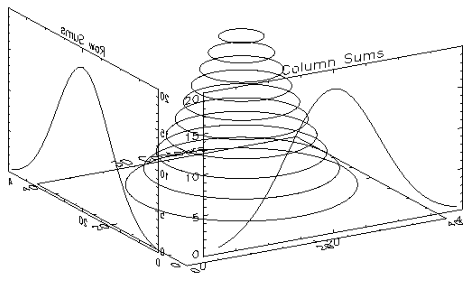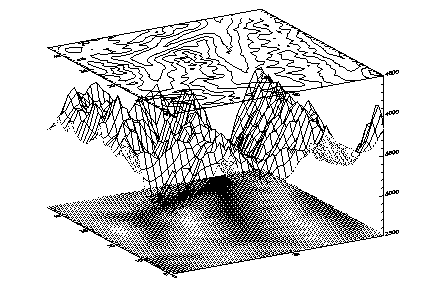3D Transformations with 2D Procedures
The CONTOUR and PLOT procedures output their results using the three-dimensional coordinate transformation contained in !P.T, if the keyword T3d is specified.
note | !P. T must contain a valid transformation matrix prior to using the T3d keyword. |
The PLOT procedures output graphs in the XY plane at the normal coordinate z value given by the keyword ZValue. If ZValue is not specified, the plot is drawn at the bottom of the unit cube, at z=0.
CONTOUR draws axes at Z=0, and contours at their Z data value if ZValue is not specified. If ZValue is present, CONTOUR draws both the axes and contours in the XY plane at the given Z value.
Combining CONTOUR and SURFACE Procedures
You can combine the output of SURFACE with the other graphics procedures. The keyword Save causes SURFACE to save the graphic transformation it used in !P.T. Then, when CONTOUR or PLOT are called with the keyword T3d, their output is transformed with the same projection.
For example, Figure 5-17: Combined Contour and Surface Plots illustrates SURFACE combined with CONTOUR. In essence, this a combination of Figure 5-2: Improved Contour Plot and Figure 5-11: Maroon Bells Surface Plots. Using the same variables as discussed in "Drawing Contour Plots with CONTOUR" and "Drawing a Surface", this figure was produced with the following statements:
; Make the mesh.
SURFACE, c, x, y, SKIRT=2650, /Save
; Make Contour plot. Specify T3D to align with Surface, at ZVALUE
; of 1.0. Suppress clipping as plot is outside normal plot window.
CONTOUR, b, x, y, /T3d, /Noerase, Title = 'Contour Plot', $
Max_val=5000., Zvalue = 1.0, /Noclip, Levels = 2750. + $
FINDGEN(6)*250
 |
Even More Complicated Transformations are Possible
Figure 5-18: PLOT and CONTOUR with 3D Transformations illustrates the application of three-dimensional transforms to the output of CONTOUR and PLOT. It shows a three-dimensional contour plot with the contours stacked above the axes in the Z direction, the sum of the columns, also a Gaussian, in the XZ plane, and the sum of the rows in the YZ plane.
 |
The code used to draw Figure 5-18: PLOT and CONTOUR with 3D Transformations is:
nx=40
temp = SHIFT(DIST(40), 20, 20)
z = EXP(-(temp/10)^2)
; Define 3D plot window. X = .1 to 1, Y = .1 to 1, 1 and Z = 0 to 1.
pos = [.1, .1, 1, 1, 0, 1]
; Make the stacked contours. Use 10 contour levels.
CONTOUR, z, /T3D, NLEVELS=10, /Noclip, Position = pos, $
Charsize = 2
; Swap y- and z-axes. The original XYZ system is now XZY.
T3D, /Yzexch
; Plot the column sums in front of the contour plot.
PLOT, z # REPLICATE( 1., nx), /Noerase, /Noclip, /T3d, $
Title = 'Column Sums', Position=pos, Charsize=2
; Swap x- and z-axes,original XYZ is now YZX.
T3D, /Xzexch
PLOT, REPLICATE( 1., nx) # z, /Noerase, /T3d, /Noclip, $
Title = 'Row Sums', Position = pos, Charsize = 2
The basic steps are:
z # REPLICATE(1., nx)creates a row vector containing the sum of each column in the two-dimensional array z. The Noerase and Noclip keywords are specified to prevent erasure and clipping. This plot appears in the XZ plane because of the previous axis exchange.
Combining Images with 3D Graphics
Images are combined with 3D graphics, as shown in Figure 5-19: Combined Image, Surface Mesh, and Contour, using the transformation techniques described in the previous section.
 |
The rectangular image must be transformed so that it fits underneath the mesh drawn by SURFACE. The general approach is as follows:
(m – 1, 0), (0, n – 1), and (m – 1, n – 1). Call this data coordinate system
(X, Y). Using a procedure or function similar to CVT_TO_2D, described in "Converting from 3D to 2D Coordinates", convert to device coordinates, which in this discussion are called (U, V).
X = S0,0 + S0,1U + S1,0V + S1,1UV
Y = T0,0 + T0,1U + T1,0V + T1,1UV
We solve for the four unknown S coefficients using the four equations relating the X corner coordinates to their U coordinates. The T coefficients are similarly found using the Y and V coordinates. This can be done using matrix operators and inversion or, more simply, with the POLYWARP procedure.
(max(U) – min(U) + 1, max(V) – min(V) + 1)
The SHOW3 procedure performs these operations. Look at the code for the SHOW3 procedure in the Standard Library for details of how images and graphics can be combined.





